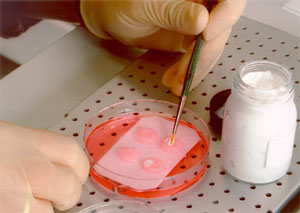

GD — Society for Dermopharmacy
 |
Issue 3 (2001) |
GD News
In artificially cultured full-thickness models identified
Active substances against skin ageing in cosmetic preparations
A positive appearance plays an increasingly important role in modern society. Especially the social class of the "young old" hardly accepts wrinkles and other visible traces of skin ageing. This is why there is a great demand for cosmetics contributing to human skin appearing younger than the actual biological age.
Dr. Thomas Förster informed about some active substances applied for this purpose by the cosmetical industry on the occasion of a symposium of the Gesellschaft für Dermopharmazie at the Fritz-Henkel-Haus in Düsseldorf on 17 October. The cosmetic chemist Förster is employed with the industrial group Schwarzkopf & Henkel in a leading position. In cooperation with the dermatologist professor Dr. med. Hans Christian Korting, Munich, and the dermatological technologist Professor Dr. Rolf Daniels, Brunswick, he was responsible for the scientific organization of the symposium visited by 120 skin experts.
Förster presented
an artificially cultured in-vitro-full thickness model in his lecture by
means of which the natural ageing processes in skin can be experimentally
simulated, thus allowing an analysis of the influences of active substances
and finished products on these processes. "The advantage is, that these
skin models have a horny layer like the human skin", Förster explained.
Active substances can be applied in a cream or gel base and tested under
realistic conditions.
In the course of skin ageing, mainly changes in the dermis, the lower cutis,
appear, namely in the composition of the matrix proteins responsible for
skin firmness and skin elasticity. But also the epidermis, the top layer
on the dermis, and the basement membrane, the connection between both skin
sectors are affected by ageing processes. Efficient anti-age products therefore
have to show a wide effectiveness range on all relevant skin layers.

Natural ageing processes of human skin can be simulated by means of
the artificially cultured in-vitro-full-thickness model and the influences
of active substances can be analyzed. Several successfully tested
anti-age-active substances could already be identified by proceeding
this way. Dr. Thomas Förster informed about these results in
the course of the symposium "Effects of Dermocosmetics"
of the Gesellschaft für Dermopharmazie in Düsseldorf on
17 October 2001.
After careful examination of the full-thickness model, several anti-age-active
substances have been identified in the laboratories of the industrial group
Schwarzkopf & Henkel with the help of which the synthesis of important
proteins in dermis, basement membrane and epidermis can be stimulated. These
substances have also proven their effectiveness in the application of already
developed market products. In controlled practical studies a reduction of
the wrinkle depth has been established for these products both by objective
measurements and subjective perception by the female consumers.
A detailed report about the GD symposium is contained in issue no.
4 (2001) of DermoTopics. Please refer to the GD-homepage (www.gd-online.de)
for the abstracts of the lectures. Further articles referring to the
individual lecture subjects will be published in the four DermoTopic
issues of the year 2002.
top